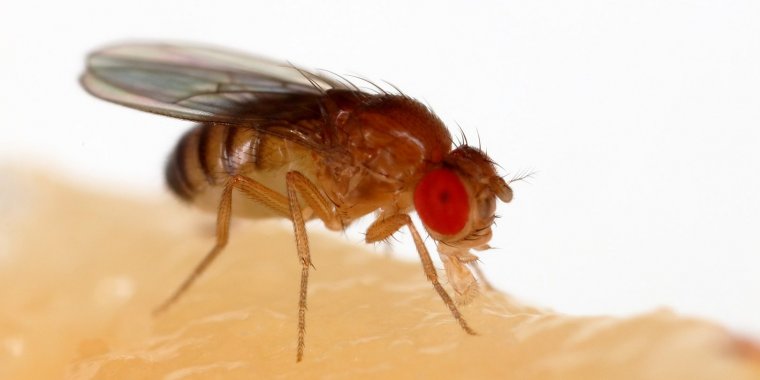| News / Science News |
First wiring map of insect brain complete
Researchers have built the first ever map showing every single neuron and how they’re wired together in the brain of the fruit fly larva.

A fruit fly (Drosophila melanogaster). Photo: Sanjay Acharya/Wikipedia
An organism's nervous system, including the brain, is made up of neurons that are connected to each other via synapses. Information in the form of chemicals passes from one neuron to another through these contact points.
The map of the 3016 neurons that make up the larva of the fruit fly Drosophila melanogaster’s brain, and the detailed circuitry of neural pathways within it, is known as a ‘connectome’.
This is the largest complete brain connectome ever to have been mapped. It is a huge advance on previous work to map very simple brain structures including the roundworm C. elegans, which only has several hundred neurons.
Imaging entire brains has until recently been extremely challenging. Now, technological advances allow scientists to image the entire brain of the fruit fly larvae relatively quickly using electron microscopy, and reconstruct the brain circuits from the resulting data.
The fruit fly larva has similar brain structures to the adult fruit fly and larger insects, and has a rich behavioural repertoire, including learning and action-selection.
“The way the brain circuit is structured influences the computations the brain can do. But, up until this point, we haven’t seen the structure of any brain except in very simple organisms,” said Professor Marta Zlatic at the University of Cambridge’s Department of Zoology and the Medical Research Council Laboratory of Molecular Biology (MRC LMB).
Zlatic led the research together with Professor Albert Cardona at the University of Cambridge’s Department of Physiology, Development and Neuroscience and the MRC LMB, and Dr Michael Winding at the University of Cambridge’s Department of Zoology.
She added: “Until now, the actual circuit patterns involved in most brain computations have been unknown. Now we can start gaining a mechanistic understanding of how the brain works.”
Current technology is not yet advanced enough to map the connectome of more complex animals such as large mammals. But because all brains involve networks of interconnected neurons, the researchers say that their new map will be a lasting reference for future studies of brain function in other animals.
“All brains of all species have to perform many complex behaviours: for example they all need to process sensory information, learn, choose food, and navigate their environment. In the same way that genes are conserved across the animal kingdom, I think that the basic circuit patterns that drive these fundamental behaviours will also be conserved,” said Zlatic.
To build a picture of the fruit fly larva connectome, the team used thousands of slices of the larva’s brain imaged with a high-resolution electron microscope, to reconstruct a map of the fly’s brain - and painstakingly annotated the connections between neurons. As well as mapping the 3016 neurons, they mapped an incredible 548,000 synapses.
The researchers also developed computational tools to identify likely pathways of information flow and different types of circuit patterns in the insect’s brain. They found that some of the structural features are similar to state-of-the-art deep learning architecture.
“The most challenging aspect of this work was understanding and interpreting what we saw. We were faced with a complex neural circuit with lots of structure. In collaboration with Professor Priebe and Professor Vogestein’s groups at Johns Hopkins University, we developed computational tools to predict the relevant behaviours from the structures. By comparing this biological system, we can potentially also inspire better artificial networks,” said Zlatic.
“This is an exciting and significant body of work by colleagues at the MRC Laboratory of Molecular Biology and others,” said Jo Latimer, Head of Neurosciences and Mental Health at the Medical Research Council.
She added: “Not only have they mapped every single neuron in the insect’s brain, but they’ve also worked out how each neuron is connected. This is a big step forward in addressing key questions about how the brain works, particularly how signals move through the neurons and synapses leading to behaviour, and this detailed understanding may lead to therapeutic interventions in the future.” (University of Cambridge)
YOU MAY ALSO LIKE





